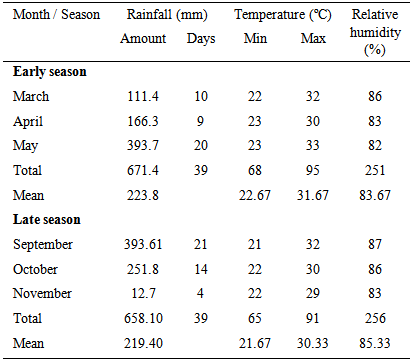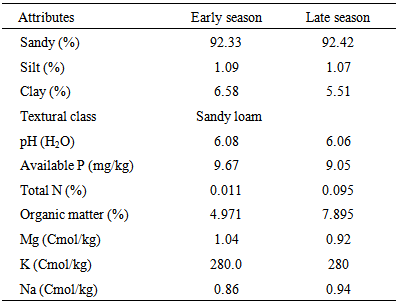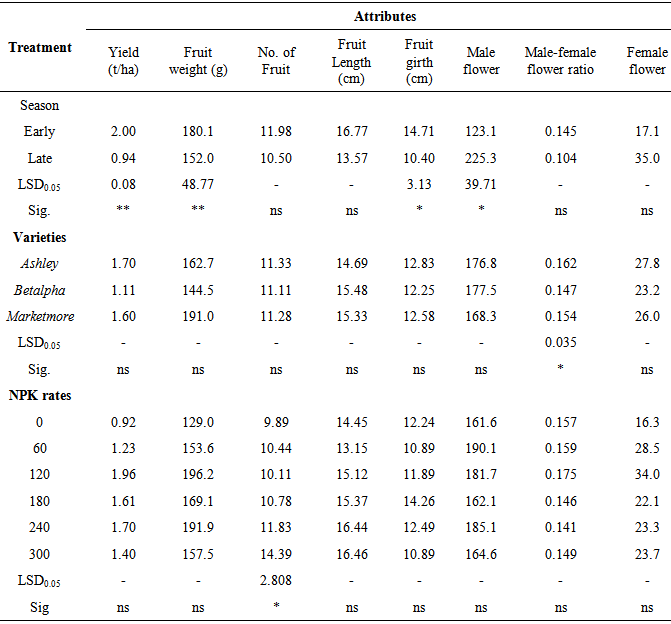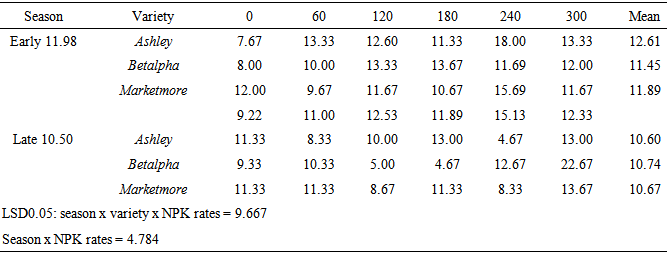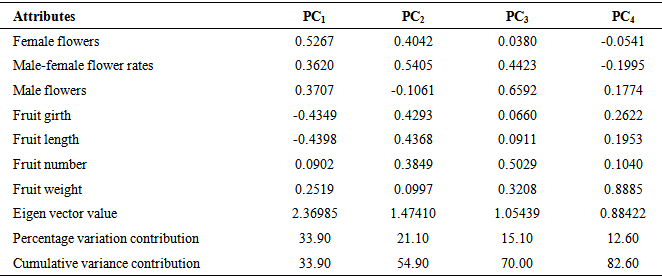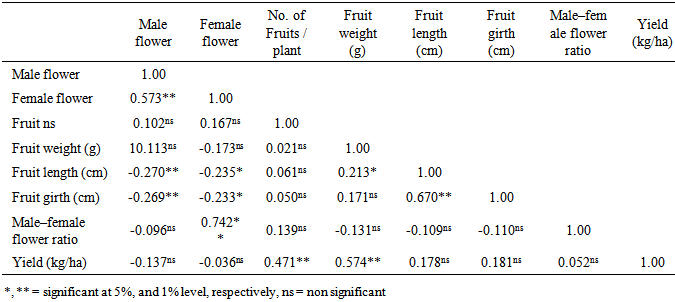| [1] | Abdi, H. and Williams, L.J. (2010). Principle Component Analysis. Wiley Interdisciplinary, Reviews Computational Statistics. 2: 433-459. |
| [2] | Adekiya, A.O. and Ojeniyi, S.O. 2002. Evaluation of tomato growth and soil properties under methods of seedling bed preparation in an Alfisol in the rainforest zone of southwest Nigeria. Bio-resource Technol., 96: 509-516. |
| [3] | Afangideh, U., Uyoh, E.A., Ittah, M. and Uko, A.E. 2005. Morphological characterization of some cultivars of cucumber (Cucumis sativus L.). J. Sustain. Trop. Agric. Res., 14: 13 - 18. |
| [4] | Allaby, M. (2002). Enclyclopedia of weather and climate. New York. |
| [5] | Arankumar, K.H., Patil, M.G., Hunchinmamani, C.N., Goud, I.S., Thiremath, S.V. 2011a. Genetic relationship of growth and development traits with fruit yield in F2 population of BGDLX hot season of cucumber (Cucumis sativus L.). karnataka J. Agric. Sci., 24: 497-500. |
| [6] | Arunkumar, K.H., Ramanjinapa, V., Ravishankar, M. 2011b. Path coefficient analysis in F2 population of cucumber (Cucumis sativus L.). Plant Archives. 11: 471-474. |
| [7] | Belay, A.A., Classens, S., Wehner, F.C. and De Beer, J.M. 2001. Influence of residual manure on selected nutrient elements and microbial composition of soil under long term crop rotation. South African J. Plant and soil, 18:1-6. |
| [8] | Best, K. 2000. Adaptation of cabbage varieties. ARP Training Reports. AVRDC-AFRICA. Regional Programme, Arusha, Tanzania. 10 pp. |
| [9] | Bremner, J.M. and Mulvaney, C.S. 1982. Nitrogen total. In: Page, A.L., Miller, P.H., Keeney, D.R, editors. Methods of soil analysis. Part 2. Chemical and microbiological properties. (2nd ed.). Madison (W1): American Soc. Agron. pp.595-262. |
| [10] | Cramer, C. and Wehner, T. 2000. Path Analysis of the Correlation between Fruit Number and plant traits of cucumber populations. Hortsci., 35(4): 708–711. |
| [11] | Cui, H., Zang, M., Meng, H. and Deng, J. 1995. Principal component analysis for traits selection in cucumber breeding. Cucurbit Genetics Cooperative Report, 18 (5): 10-12. |
| [12] | Dewey, D.R. and Lu, K.H. 1959. A correlation and path coefficient analysis of components of crested wheatgrass seed production. Agron. J., 51:515–518. |
| [13] | Eifediyi, E.K. and Remison, S.U. 2010. Growth and yield of cucumber (Cucumis sativus L.) as influenced by farmyard manure and inorganic fertilizer. Researcher, 2(4): 1-6. |
| [14] | FDALR., 1985. Federal Department of Agriculture and Land Resources Reconnaissance Soil Survey of Anambra State, Nigeria, Soil Report, FDALR., Kaduna, Nigeria. |
| [15] | Gee, G.W. and Brauder, J.W. 1986. Particle size analysis. In: Klute, A. (eds.). Methods of soil Analysis. Part 1. Monograph No. 9. America Soc. Agron., Madison, W1. 91-100. |
| [16] | Genstat Committee (2003). Reference Manual (Genstat Release 7.0) VSN International Limited, Oxford, Uk. www. discovery. genstat. co uk. |
| [17] | Golabadi, M., Eghtedary, A.R., Golkar, P.P. 2013. Determining relationships between different horticultural traits in (Cucumis sativus L.) Genotypes with multivariate analysis. Sabrao J. Breeding and Genet., 45 (3): 447-457. |
| [18] | John, L.W., James, D.B., Samuel, L.T. and Warner, L.W. 2004. Soil Fertility and Fertilizers: An Introduction to Nutrient Management. Pearson Education, India. pp.106–53. |
| [19] | Kundsen, D., Peterson, G.A. and Pratt, P.F. 1982. Lithium, Sodium and Potassium. In: page, A.L. (ed.). Methods of soil analysis. Part 2. Monograph, No. 9. American Soc. Agron., Madison, W1., pp. 241-262. |
| [20] | Lanyon, L.E. and Heald, W.R. 1984. Magnesium, Calcium, Strontium and Barium. In: Page, A.L. (ed.). Methods of soil Analysis. Part 2. Monograph, No. 9. American Soc. of Agron., Madison, W1. pp. 241-262. |
| [21] | Mahmoud, E., Abd EL- Kader, N., Robin, P., Akkal-Corfini, N. and Abd El-Rahman, L. 2009. Effects of Different Organic and Inorganic Fertilizers on Cucumber Yield and Some Soil Properties. World J. Agric. Sci., 5 (4): 408-414. |
| [22] | Makinde, A.A and Bello, N.J. 2009. Effects of soil temperature pattern on the performance of cucumber intercrop with maize in a tropical wet-and-dry climate of Nigeria. Researcher, 1(2): 24-36. www.sciencepub.net, sciencepub@gmail.com. |
| [23] | Mclean, E.O. 1982. Soil pH and lime requirements. In: Page A.L., Miller, P.H., Keeney. DR., editors. Methods of soil analysis. Part 2. Chemical and microbiological properties. (2nd ed.) Madison (W1): American Soc. Agron., pp. 199-124. |
| [24] | Miller, P.A., Williams, J.C., Robinson, H.F. and Comstock, R.E. 1958. Estimates of genotypic and environmental variances and covariances in upland cotton and their implications in selection. Agron. J., 50:126-131. |
| [25] | Mohammadi, S.A. and Prasanna B.M. 2003. Analysis of genetic diversity in crop plants salient statistical tools and considerations. Crop Sci., 43: 1235–1248. |
| [26] | Obi, I.U. and Obi, E. 2002. Statistical Methods of Detecting Differences Between Treatment Means and Methodology Issues in Laboratory and Field Experiments. (2nd ed.), AP Express Publishing Company, Limited, Nsukka, Nigeria. 116 pp. |
| [27] | Ogbodo, E.N., Okorie, P.O. and Utobo, E.B. 2010. Introducing cucumber for cultivation at New different zone in Ebonyi State, southeastern, Nigeria. Libyan Agric. Res. Cent. J. Internl., 1 (16): 336-343. |
| [28] | Olsen, S.R. and Sommers, L.E. 1982. Phosphorus. In: Page, A.L., Miller, R.H. and Keenye, D.R. (eds.). Methods of soil Analysis, Part 2. (2nd ed). America Soc. Agron., Inc. Madison, W1. |
| [29] | Perl-Treves, R.1999. Male to female conversion along the cucumber shoot: approaches to study sex genes and floral development in Cucumis sativus. In: Ainsworth, C.C. (ed.). Sex determination in plant. Oxford: BIOS Scientific Publishers, 189-286. |
| [30] | Rao, E.S., Munshi, A.D., Verma, V.K. 2004. Genetic association and interrelationship of yield and its components in cucumber (Cucumis sativus L.). Indian J. Hort., 61: 315-318. |
| [31] | Shehata, S.A., Yasser, M.A., Youssef, T.E. and Mahmoud A.A. 2012. Influence of some organic and inorganic fertilizers on vegetative growth, yield and yield components of cucumber plants. Res. J. Agric. and Biol. Sci., 8(2): 108-114. |
| [32] | Shetty, N.V and Wehner, T.C. 2002a. Estimation of fruit grade weights based on fruit number and total fruit weight in cucumber. Hort. Sci., 37: 1117-1121. |
| [33] | Shetty, N.V. and Wehner, T.C. 2002b. Screening the cucumber gerplasm collection for fruit yield and quality. Crop sci., 42: 2174-2183. |
| [34] | Singh, A. and Ram, H.H. 2012. Estimates of stability parameters for yield and its components in cucumber (Cucumis sativus L.). Vegetable Sci., 39 (1): 31-34. |
| [35] | Solanki, S.S. and Shah, A. 1989. Path analysis of fruit yield components in cucumber. Progressive Hort., 21: 322–324. |
| [36] | SPSS Statistical Package for Windows (2010). SPSS for windows. Release 17.0 Standard Version. |
| [37] | Statistical Analysis System. 2002. Guides for personal computers. Version 9.00 (ed.). SAS Institute Inc., Cary NC. USA. |
| [38] | Staub, J.E., Chung, S.M. and Fazio, G. 2005. Conformity and genetic relatedness estimation in crop species having a narrow genetic base: The case of cucumber (Cucumis sativus L.). Plant Breeding, 124: 44-53. |
| [39] | Staub, J.E., Serquen, F.C. and McCreight, J.D. 1997. Genetic diversity in cucumber (Cucumis sativus L.): III. An evaluation of Indian germplasm. Genetics. Res. Crop Evol., 46: 297-310. |
| [40] | Steel, R.G., Torie, J.H. and Dickey, D.A. 1997. Principles and Procedures of Statistics: A Biometrical Approach. (3rd ed.). McGraw Hill, Co. Inc. New York, 666 pp. |
| [41] | Tatliogu, T. 1993. Cucumber (Cucumis sativus L.) In: Kailor, G. and Bo Bergn, (eds.). Genetic improvement of vegetable crops. Oxford Pergamon Press, pp. 197-227. |
| [42] | Thoa, D.K. 1998. Cucumber seed multiplication and characterization. AVRDC/ARC Training, Thailand. |
| [43] | United States Department of Agriculture, Agricultural Research Service, Nutrient Data Laboratory. 2014. USDA National Nutrient Database for standard reference, Release 27. 128 pp. |
| [44] | Vimala, P., Ting, C.C., Salbiah, H., Ibrahim, B. and Ismail, L. 1999. Biomass production and nutrient yields of four green manures and their effects on the yield of cucumber. J. Trop. Agric. and Food Sci., 27: 47-55. |
| [45] | Wehner, T.C. and Guner, N. 2004. Growth stage, flowering pattern, yield and harvest date prediction of four types of cucumber tested at 10 planting dates. Proc. XXVI IHC-Advances in Vegetable Breeding. (eds.). McCreight, J.D. and Ryder, E.J., Acta Hort., 637: 223-229. |
| [46] | Wright S. 1960. Path coefficient and path regression: alternative or complementary concepts? Biomet., 16: 189–202. |
| [47] | Wright S. 1934. The method of path coefficients. Ann. Math. Stat. 5:161–215. |
| [48] | Yamasaki, S., Fuji, N. and Takahashi, H. 2005. Hormonal regulation of sex expression in plants. Vitamins and Hormones, 72: 79-110. |

 Abstract
Abstract Reference
Reference Full-Text PDF
Full-Text PDF Full-text HTML
Full-text HTML